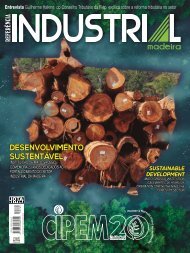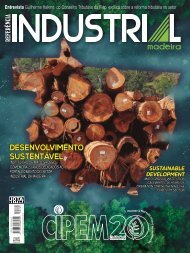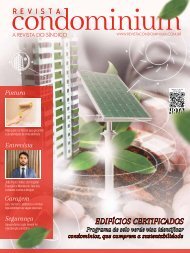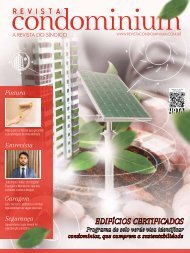MadeiraIndustrial_254Web
You also want an ePaper? Increase the reach of your titles
YUMPU automatically turns print PDFs into web optimized ePapers that Google loves.
ENTREVISTA<br />
indefinidamente, pois alcançam rapidamente a saturação,<br />
seja na capacidade de endividamento das famílias, seja<br />
no alcance da infraestrutura física da economia. Por isso,<br />
a melhor política de combate ao desemprego e apoio à<br />
indústria está no incentivo ao investimento em todas as<br />
suas vertentes, tanto na ampliação da capacidade de produção<br />
das fábricas, quanto na logística de escoamento<br />
dessa produção. O incentivo ao investimento passa por<br />
tudo o que foi discutido aqui, com a redução do Custo<br />
Brasil e políticas direcionadas para o setor industrial.<br />
QUAL A EXPECTATIVA PARA O SETOR INDUS-<br />
TRIAL NOS PRÓXIMOS ANOS?<br />
O panorama econômico nacional neste ano, embora<br />
não seja otimista, está melhorando com a constante reavaliação<br />
das projeções de crescimento do PIB. Para os<br />
próximos anos, tudo dependerá em grande medida da<br />
capacidade do governo federal em arrumar a casa e construir<br />
bases sólidas para sustentar um novo ciclo de crescimento<br />
a partir de 2024. O fato é que a economia brasileira<br />
perdeu o ritmo de crescimento desde março de 2022,<br />
após alcançar taxas anualizadas de crescimento de 4,9%<br />
em fevereiro de 2022, encerrando o ano com crescimento<br />
de 2,9%. O baixo crescimento do PIB brasileiro ainda reflete<br />
os impactos do aperto monetário, que resultou em<br />
uma das maiores taxas reais de juros do mundo. Isso encarece<br />
o crédito, com impactos para o consumo e para os<br />
investimentos. O cenário internacional também é nebuloso.<br />
Ainda persistem as medidas dos governos dos principais<br />
países em controlar a inflação, que atingiu níveis muito<br />
elevados. Por conta disso, os bancos centrais dos EUA<br />
(Estados Unidos da América) e da Europa promoveram<br />
forte elevação dos juros, reduzindo a liquidez mundial e<br />
encarecendo suas moedas. A economia chinesa, por sua,<br />
vez ainda tenta voltar ao crescimento dos últimos anos,<br />
mas encontra dificuldades em virtude da desestruturação<br />
dos mercados pós-covid. Nesse cenário de desaceleração<br />
econômica, a tendência é de queda dos preços das<br />
commodities. Por esta razão, recentemente os países da<br />
OPEP+ (Organização dos Países Exportadores de Petróleo)<br />
cortaram a produção de petróleo na tentativa de conter<br />
os preços. Adicione-se os efeitos da persistente guerra<br />
na Ucrânia. Por tudo isso, o crescimento projetado pelo<br />
Banco Mundial para as economias avançadas é de apenas<br />
0,5% e para o mundo em 2023 é de 1,7%. Para o setor<br />
industrial, o Brasil pode aproveitar a nova configuração da<br />
economia internacional (friendshoring e nearshoring) para<br />
impulsionar sua industrialização.<br />
the best policy to combat unemployment and support<br />
the Industrial Sector is to encourage investment in all<br />
its aspects, in both expansion of production capacity<br />
and the logistics of the flow of this production. The<br />
incentive to invest goes through everything that has<br />
been discussed here, with the reduction of the Custo<br />
Brasil and policies directed to the Industrial Sector.<br />
WHAT IS THE EXPECTATION FOR THE INDUS-<br />
TRIAL SECTOR IN THE COMING YEARS??<br />
While not optimistic, Brazil’s economic outlook for<br />
this year is improving with the constant reassessment<br />
of GDP growth projections. For the next few years,<br />
everything will largely depend on the Federal Government’s<br />
ability to reorganize and build solid foundations<br />
to sustain a new cycle of growth starting in 2024. The<br />
Brazilian economy has had a lower pace of growth<br />
since March 2022, after reaching an annualized growth<br />
rate of 4.9% in February 2022, ending the year with<br />
2.9%. Brazil’s low GDP growth still reflects the impacts<br />
of monetary tightening, which has resulted in one of<br />
the highest real interest rates in the world. This makes<br />
credit more expensive, with impacts on consumption<br />
and investment. The international scene is also hazy.<br />
The measures of the governments of the leading countries<br />
to control inflation, which has reached very high<br />
levels, persist. Because of this, the central banks of<br />
the United States and Europe promoted a substantial<br />
increase in interest rates, reducing global liquidity and<br />
making their currencies more expensive. For its part,<br />
the Chinese economy is still trying to return to the<br />
growth of recent years but is struggling due to the disruption<br />
of post-Covid markets. In this economic slowdown<br />
scenario, the tendency is for commodity prices<br />
to fall. For this reason, OPEC+ countries recently cut oil<br />
production in an attempt to contain prices. Add to that<br />
the effects of the persistent war in Ukraine. With all this,<br />
the growth projected by the World Bank for advanced<br />
economies is only 0.5%, and for the world in 2023, it is<br />
1.7%. Brazil can use the new configurations of the international<br />
economy, friendshoring and nearshoring, for<br />
the Industrial Sector to boost its industrialization.<br />
A ATUAÇÃO CONJUNTA DOS SETORES PÚBLICO E PRIVADO PARA A<br />
PROMOÇÃO DE INVESTIMENTOS NECESSÁRIOS AO PAÍS É FUNDAMENTAL<br />
PARA O DESENVOLVIMENTO DA NOSSA INDÚSTRIA<br />
52 referenciaindustrial.com.br AGOSTO 2023

















